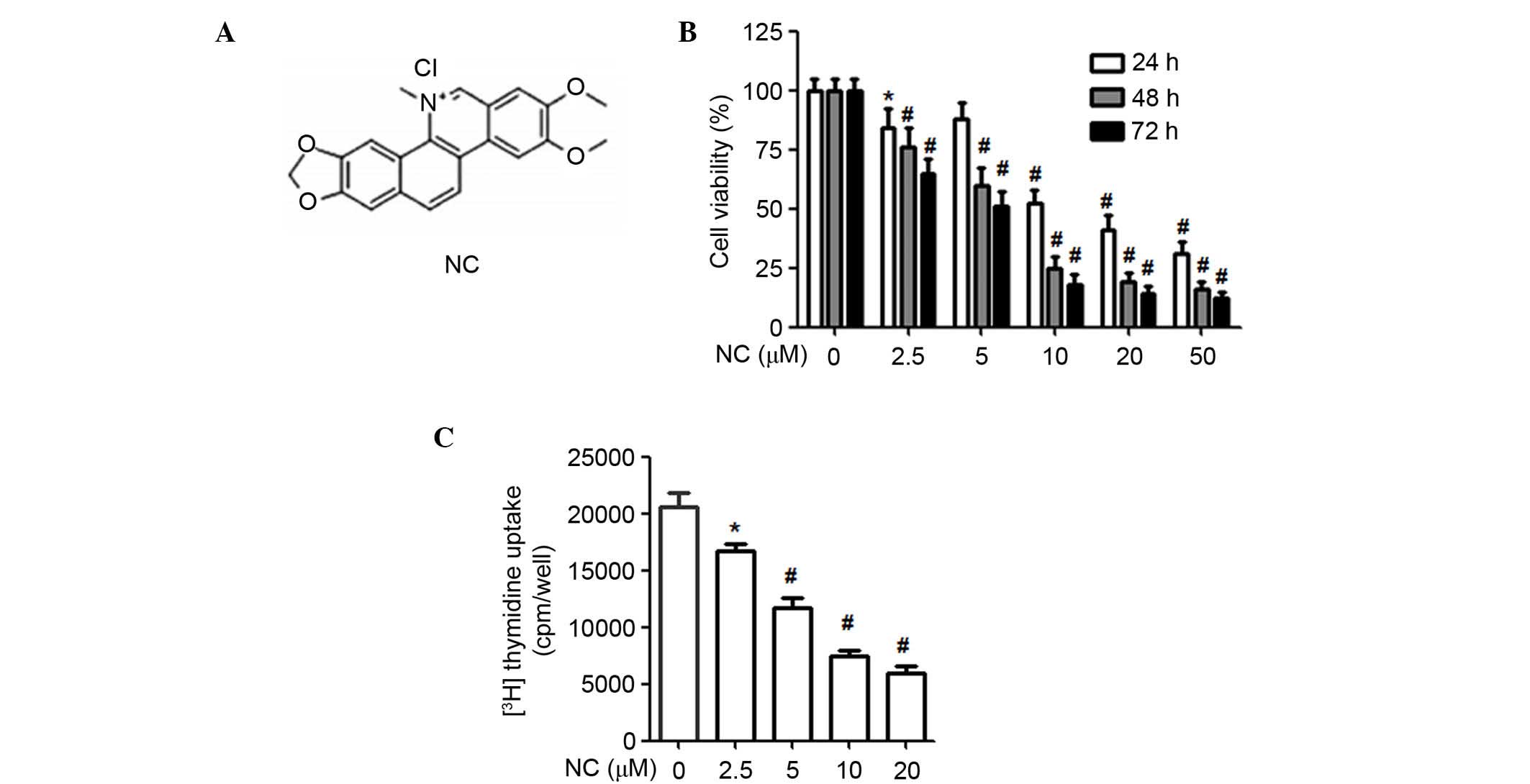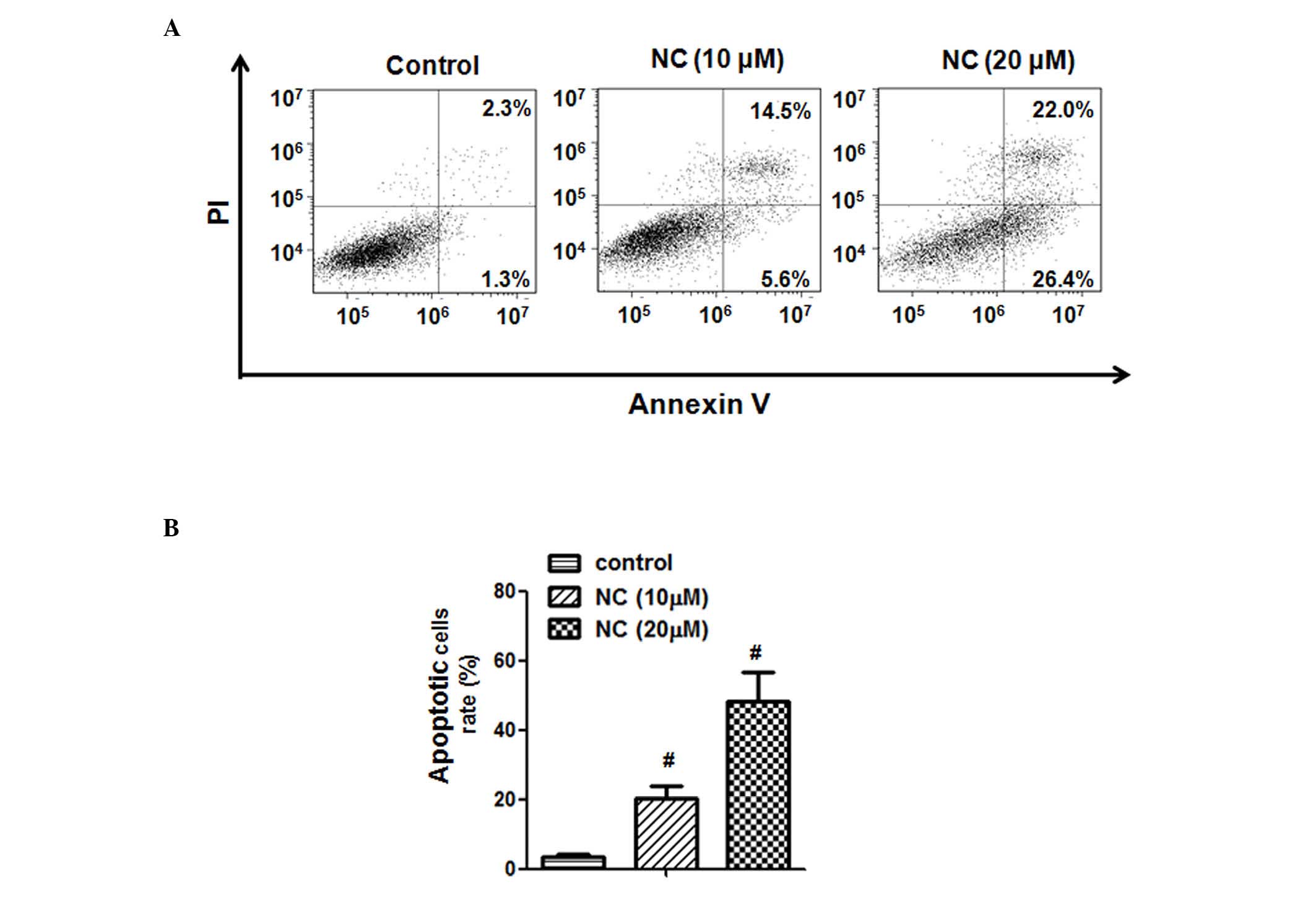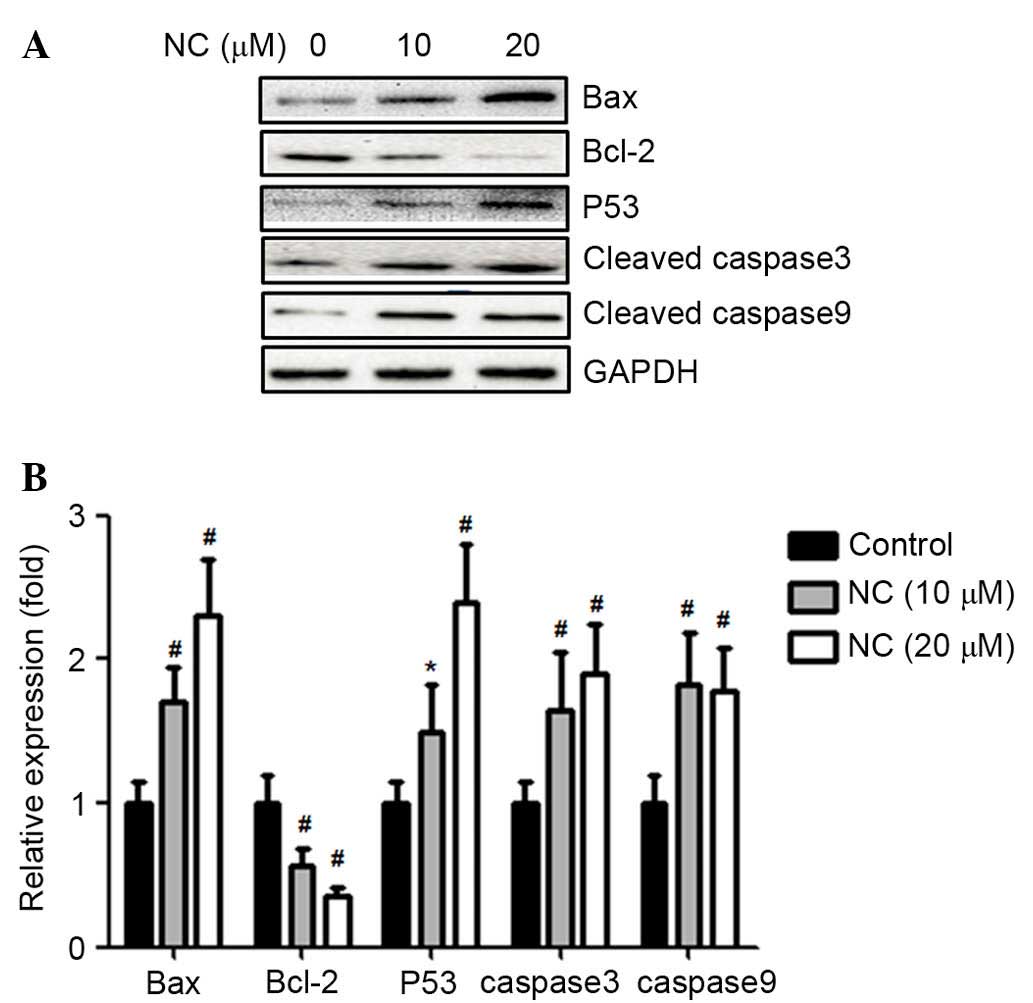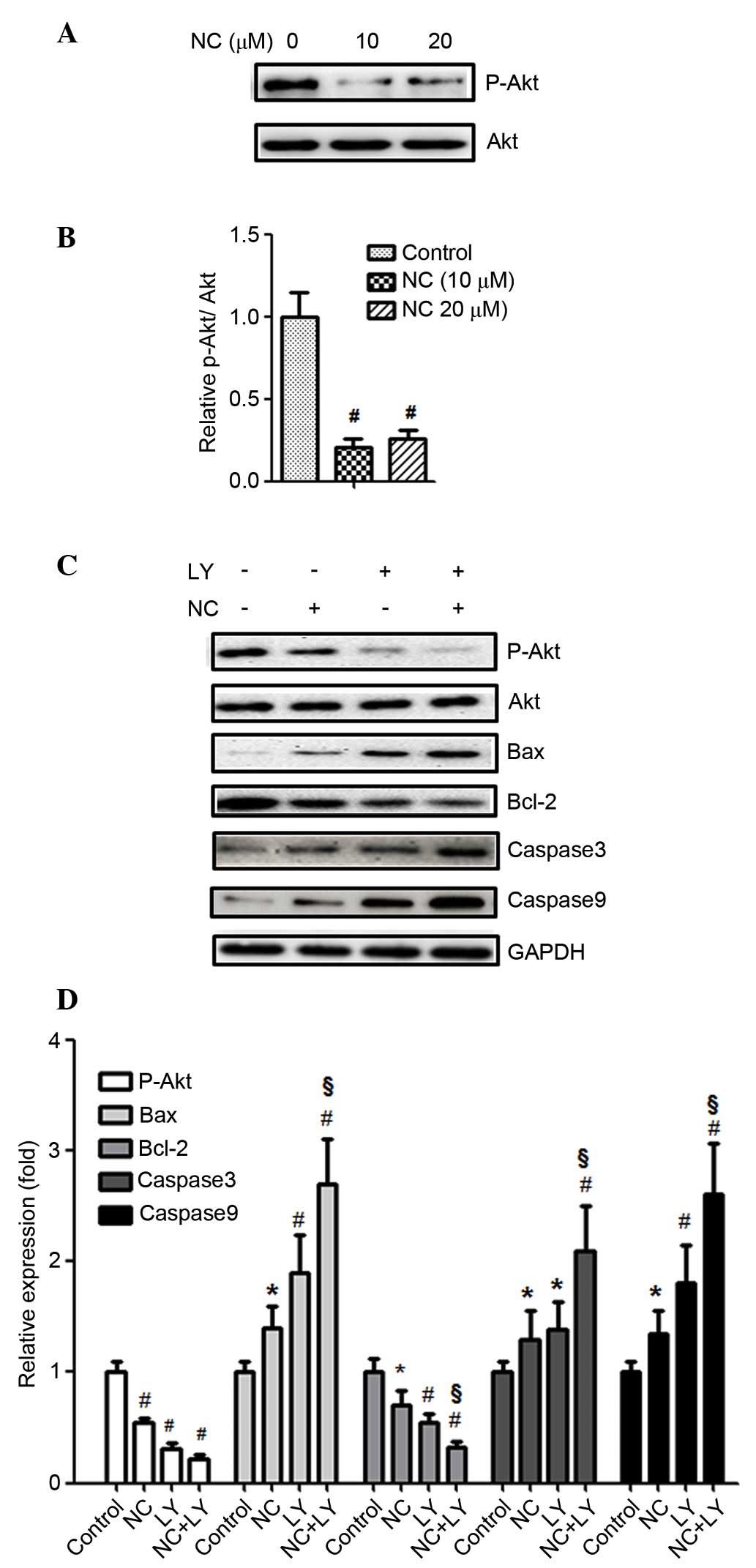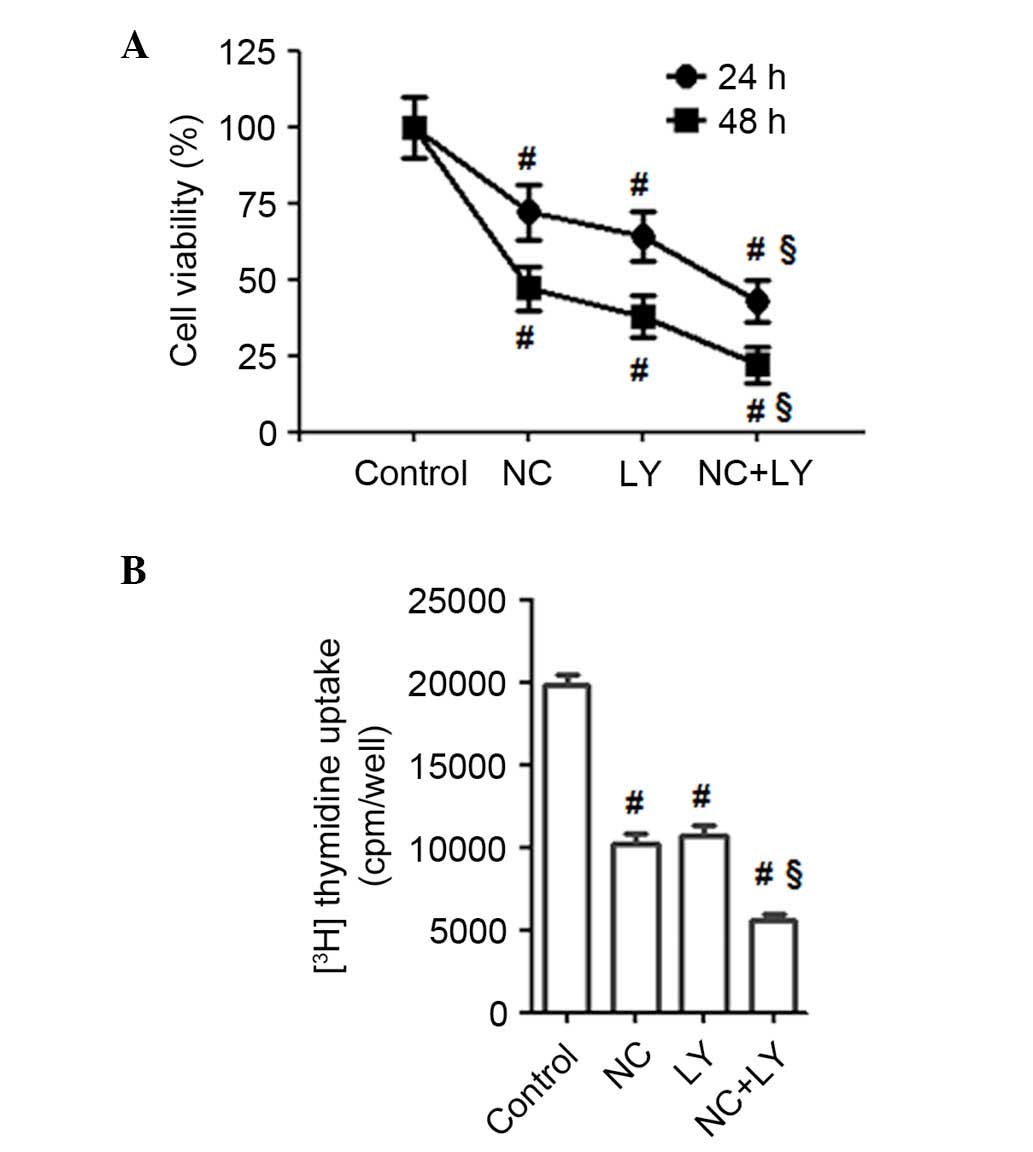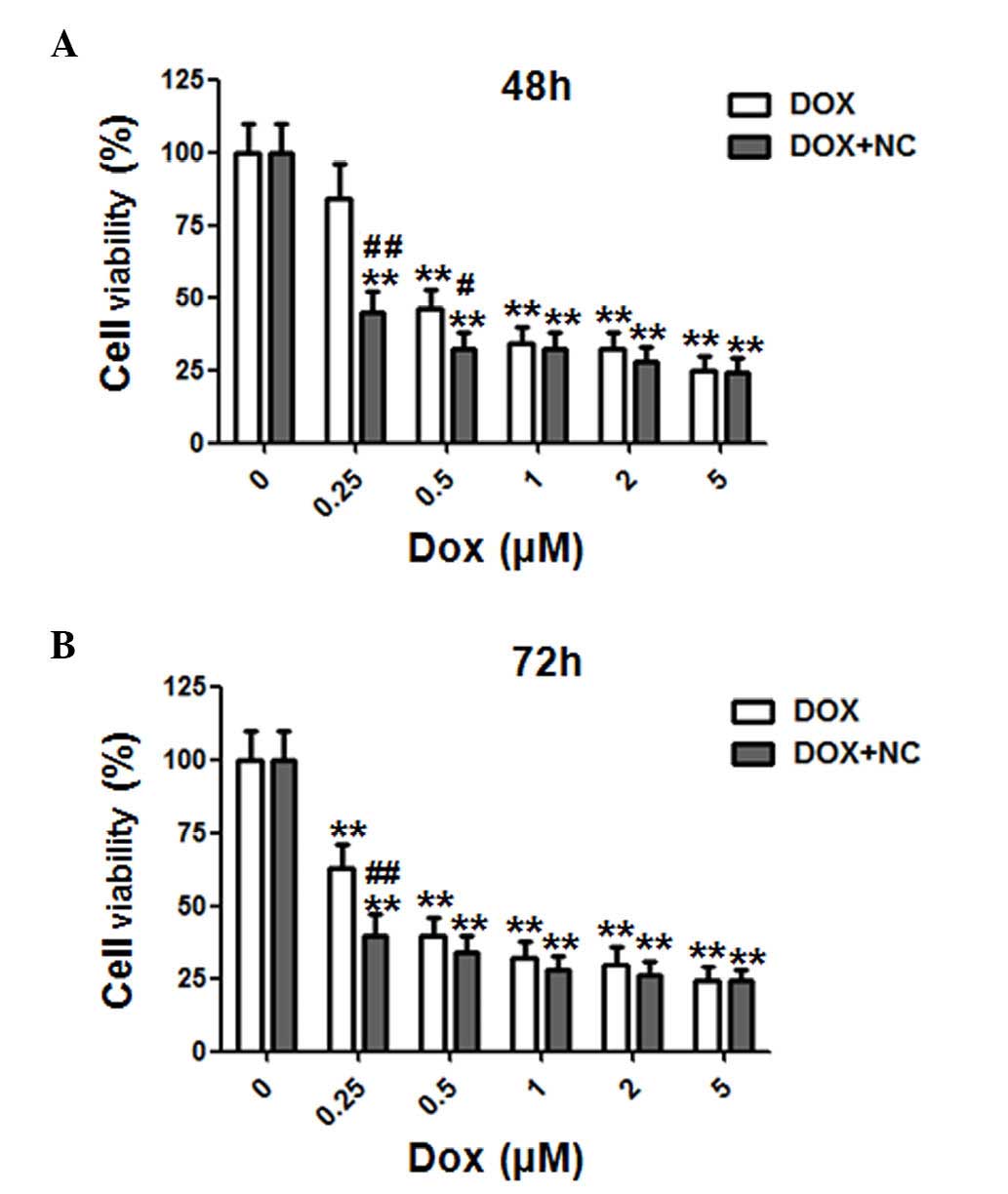Nitidine chloride inhibits proliferation, induces apoptosis via the Akt pathway and exhibits a synergistic effect with doxorubicin in ovarian cancer cells
- Authors:
- Published online on: July 29, 2016 https://doi.org/10.3892/mmr.2016.5577
- Pages: 2853-2859
Abstract
Introduction
Ovarian cancer is a lethal gynecological malignancy and the fifth leading cause of cancer-associated mortality worldwide. In 2013, there were >2 million novel cases of ovarian cancer and 1 million mortalities worldwide (1–3). Chemotherapy following surgical resection is the current primary treatment for localized ovarian cancer. Progress has been made in early diagnosis of patients; however, treatment options for the majority of patients with advanced stage ovarian cancer remain limited. Particularly, resistance to chemotherapeutical drugs often leads to poor prognosis (4–6). Therefore, it is important to investigate the potential molecular mechanisms underlying the pathogenesis of ovarian cancer, and to identify novel therapeutic agents and combination regimens in order to improve the treatment and prognosis of patients with ovarian cancer.
Nitidine chloride (NC) (Fig. 1A) is isolated from the root of Zanthoxylum nitidum (Roxb). Numerous pharmacological properties of NC have been previously reported, including anti-oxidant, anti-inflammatory, anti-fungal, analgesic and anti-human immunodeficiency virus functions (7,8). Previous studies have determined that NC exhibits anti-tumor activity in several types of cancer. Additionally, NC inhibits cell proliferation and induces apoptosis in renal cancer, gastric cancer, breast cancer and hepatocellular carcinoma (9–12). NC was also capable of suppressing the invasion and metastasis of renal cancer via the Akt serine/threonine kinase 1 (Akt) pathway, and breast cancer by inhibiting the SRC proto-oncogene, non-receptor tyrosine kinase/focal adhesion kinase-associated signaling pathway (13,14). However, to the best of our knowledge, no evidence has previously reported whether NC exerts any effect on ovarian cancer proliferation, apoptosis and its underlying mechanisms. NC may be successful in treating ovarian cancer; however, the synergistic effect of NC and other therapeutic agents requires further investigation.
The present study investigated the effects of NC on ovarian cancer cell proliferation and apoptosis. It was also determined that the Akt pathway is important for NC-induced apoptosis. Additionally, the synergistic effect of NC with doxorubicin (DOX) on ovarian cancer cells was evaluated.
Materials and methods
Cell lines and reagents
The A2780 human ovarian cancer cell line was purchased from the American Type Culture Collection (Manassas, VA, USA) and cultured in RPMI-1640 (Invitrogen; Thermo Fisher Scientific, Inc., Waltham, MA, USA) containing 10% fetal bovine serum (FBS; Invitrogen; Thermo Fisher Scientific, Inc.), 100 U/ml penicillin, and 100 µg/ml streptomycin in 5% CO2 at 37°C. Rabbit anti-Akt (cat. no. 4685), phosphorylated-Akt (cat. no. 4058), B-cell CLL/lymphoma 2 (Bcl-2; cat. no. 2870), Bcl-2-associated X protein (Bax; cat. no. 502), p53 (cat. no. 2527), caspase-3 (cat. no. 9665) and -9 (cat. no. 9502) antibodies were purchased from Cell Signaling Technology, Inc. (Danvers, MA, USA). NC was purchased from Tauto Biotech Co., Ltd. (Shanghai, China) and dissolved in dimethyl sulfoxide (DMSO). LY294002, a selective phosphatidylinositol-4,5-bisphosphate 3-kinase (PI3K) Akt inhibitor, was purchased from Sigma-Aldrich (St. Louis, MO, USA). Annexin V-fluorescein isothiocyanate (FITC)/propidium iodide (PI) apoptosis detection kit was purchased from BD Biosciences (Franklin Lakes, NJ, USA).
Methyl thiazolyl tetrazolium (MTT) assay of cell viability and proliferation
Cell viability and proliferation were detected by using MTT assay. A2780 cells in 100 µl RPMI-1640 were seeded at a density of 5.0×103 cells/well in 96-well plates. Following treatment with NC (0, 2.5, 5, 10, 20 or 50 µM) and/or DOX (0, 0.25, 0.5, 1, 2, 5 µM; Aladdin Reagents Co., Ltd., Shanghai, China) for different time-points (24, 48 or 72 h), 20 µl MTT (5 mg/ml) was added to each well. Subsequently, the cells were incubated for 4 h, then 100 µl DMSO was added to each well for another 15 min. Finally, the absorbance values were detected using a microplate luminometer (Bio-Rad Laboratories, Inc., Hercules, CA, USA) at 490 nm.
3H-thymidine incorporation assay
A2780 cells were cultured in RPMI-1640 with 10% FBS at 50% confluence. Next, the A2780 cells were cultured in serum-free RPMI-1640 for 24 h and treated with NC at different concentrations (0, 2.5, 5, 10, 20 µM) for 40 h. 3H-thymidine (final concentration 1 uCi/ml) was added to the media during the last 24 h of culturing. The cells were then washed with ice-cold phosphate-buffered saline (PBS), and precipitated with ice-cold 5% trichloroacetic acid (TCA; Sigma-Aldrich) for 4 h. The cells were washed with ice-cold 5% TCA twice, followed by washed with ice-cold PBS. Subsequently, the cells were lysed using 200 µl 0.5 M NaOH for 30 min at 37°C. DNA synthesis was determined by 3H-thymidine uptake using a liquid scintillation counter (LS-6500; Beckman Coulter, Inc., Brea, CA, USA).
Western blot analysis
Total cell protein concentrations were detected by using the Pierce bicinchoninic acid protein assay kit (Thermo Fisher Scientific, Inc.). Equal quantity of protein from cell lysates (10 µg) were loaded on 12% sodium dodecyl sulfate-polyacrylamide gel electrophoresis gels. Following electrophoresis, proteins were transferred to polyvinylidene fluoride membranes (EMD Millipore, Billerica, MA, USA), blocked with 5% fat-free milk at room temperature for 1 h, and incubated with the aforementioned primary antibodies overnight at 4°C. The membranes were subsequently washed with Tris-buffered saline Tween-20 and incubated with horseradish peroxidase-conjugated goat anti-rabbit secondary antibodies (cat. no. ZDR-5306; OriGene Technologies, Inc., Shanghai, China) for 1 h at room temperature. Immune complexes were detected with enhanced chemiluminescence reagents (EMD Millipore), and the blots were quantified by densitometric analysis using the AlphaImager IS 2200.
Apoptosis analysis by Annexin V/PI assay
Apoptosis of A2780 cells was detected by using the Annexin V-FITC/PI assay. A2780 cells were seeded into 6-well plates at a density of 1.0×106 cells/well. Following NC treatment (0, 10, 20 µM) for 24 h the A2780 cells were harvested, washed and resuspended in PBS. Apoptotic cells were determined using an Annexin V-FITC apoptosis detection kit according to the manufacturer's protocol. Briefly, the A2780 cells were washed and then incubated for 15 min at room temperature in the dark in 200 µl 1X binding buffer containing 5 µl Annexin V-FITC and 10 µl PI. The apoptotic rate was detected by the BD Accuri C6 flow cytometer (BD Biosciences) and processed using FlowJo software (version 7.0; Tree Star, Inc., Ashland, OR, USA).
Statistical analysis
Data are expressed as the mean ± standard deviation. All of the experiments were repeated at least three times. Comparisons among values for all groups were performed using a one-way analysis of variance with Dunnett's test for comparison of multiple groups. P<0.05 was considered to indicate a statistically significant difference.
Results
NC inhibits the proliferation of ovarian cancer cells
An MTT assay was performed to determine the effect of NC on ovarian cancer cell proliferation. As presented in Fig. 1B, NC significantly reduced the proliferation of ovarian cancer cells in a time- and dose-dependent manner compared with the control group (P<0.01). To verify the aforementioned findings, a 3H-thymidine incorporation assay was used to determine the importance of NC on the proliferation of ovarian cancer cells. As presented in Fig. 1C, NC (2.5, 5, 10 and 20 µM) significantly suppressed the proliferation of ovarian cancer cells compared with the control (P=0.038, P=0.0071, P=0.0062, P=0.0050, respectively). The 10 and 20 µM NC concentrations were selected for the subsequent experiments. These data suggested that NC effectively suppressed the proliferation of ovarian cancer cells.
NC induces apoptosis in ovarian cancer cells
To confirm that the inhibitory effect of NC on the proliferation of A2780 ovarian cancer cells was due to the direct effect on apoptosis, the A2780 cells were treated with NC (0, 10 and 20 µM) for 24 h. As presented in Fig. 2 it was determined that 10 and 20 µM NC significantly promoted the apoptosis of ovarian cancer cells compared with the control group (P=0.0035 and P=0.0010, respectively). The apoptotic rate of ovarian cancer cells increased from 2.3±1.3 (control) to 14.5±5.6 and 22.0±26.4% following treatment with 10 and 20 µM, respectively, for 24 h. These findings demonstrated the anti-tumor effect of NC on ovarian cancer cells.
NC induces the apoptosis of ovarian cancer cells via altered expression levels of apoptosis-associated proteins
In order to determine the underlying mechanism of ovarian cancer cell apoptosis induced by NC, the protein expression levels of Bax, Bcl-2, p53, caspase-3 and -9 were determined. Western blot analysis demonstrated that, following treatment with NC (10 and 20 µM), the expression levels of pro-apoptotic protein Bax were significantly upregulated (P=0.0074 and P=0.0058, respectively; Fig. 3) and the expression levels of the anti-apoptotic protein, Bcl-2 were significantly downregulated compared with the control group (P=0.0062 and P=0.0044, respectively; Fig. 3). Simultaneously, the protein expression levels of p53 (10 µM NC, P=0.031; 20 µM NC, P=0.0040), caspase-3 (10 µM NC, P=0.0054; 20 µM NC, P=0.0057) and −9 (10 µM NC, P=0.0055; 20 µM NC, P=0.0054) were also significantly upregulated compared with the control group (Fig. 3).
NC inhibits Akt phosphorylation in ovarian cancer cells
The Akt signaling pathway is important for tumor progression. To determine the molecular mechanism involved in the effect of NC on the proliferation and apoptosis of ovarian cancer cells, the Akt signaling pathway was examined. As presented in Fig. 4A and B, Akt phosphorylation was significantly downregulated by treatment with NC (10 and 20 µM; P=0.0041 and P=0.0045, respectively) for 24 h, compared with the control group (P<0.01). This indicated that the Akt signaling pathway may be involved in the viability and apoptosis of ovarian cancer cells.
Suppression of the Akt signaling pathway enhanced the pro-apoptotic and anti-proliferative effect of NC on ovarian cancer cells
LY294002, a PI3K inhibitor, was used to stop Akt phosphorylation. As presented in Fig. 4C and D, the inhibition of Akt phosphorylation with LY294002 significantly enhanced the NC-induced downregulation of the Bcl-2 expression levels compared with NC treatment only (P=0.0061), whereas the expression levels of Bax, caspase-3 and -9 were significantly upregulated by LY294002 + NC treatment compared with 20 µM NC treatment alone (P=0.0033, P=0.0041 and P=0.0052). These findings indicated that NC-induced apoptosis may be PI3K/Akt-dependent. Furthermore, the effect of NC on the proliferation of ovarian cancer cells and the PI3K/Akt signaling pathway was determined using an MTT assay (Fig. 5A) and 3H-thymidine incorporation assay (Fig. 5B). As presented in Fig. 5A, the PI3K/Akt inhibitor LY294002, significantly enhanced the NC-induced suppression of the proliferation of ovarian cancer cells compared with the control and the NC-only treated group (P=0.0057, 24 h; P=0.0051, 48 h). As demonstrated in Fig. 5B, LY294002 enhanced 3H-thymidine incorporation compared with NC alone (P=0.0066). Therefore, blocking Akt activation may significantly enhance the NC-induced suppression of the proliferation of ovarian cancer cells.
NC exhibits a synergistic effect with DOX on limiting cell viability of ovarian cancer cells
A previous study on anti-tumor agents focused on limiting drug resistance of traditional chemotherapeutic agents by combining with novel anti-tumor drugs to achieve optimal curative effects (14). In order to investigate the synergistic effect of NC and DOX on A2780 ovarian cancer cells, the cells were treated with various doses of DOX (0, 0.25, 0.5, 1, 2, 5 µM) and NC (2 µM) for 48 and 72 h (Fig. 6A and B). The cell viability was examined by MTT assays. DOX alone or in combination with NC (2 µM) inhibited the viability of ovarian cancer cells in a time- and dose-dependent manner. Notably, the viability of A2780 cells was decreased from 84.2±11.2 to 43.5±7.1 (P=0.0063), and 45.7±6.8 to 31.8±5.3% (P=0.034), respectively, when treated with 0.25 and 0.5 µM DOX, in combination with NC (2 µM) at 48 h. For the 72 h treatment, the viability of A2780 cells decreased from 55.9±9.2 to 44.6±6.1% (P=0.0083) when treated with 0.25 µM DOX in combination with NC (2 µM). These findings indicated that the combination of DOX and NC exerted a synergistic inhibitory effect on the viability of the ovarian cancer cells.
Discussion
Uncontrolled proliferation and resistance to apoptosis of tumor cells is considered to contribute to mortality in patients with ovarian cancer (15,16). Conventional chemotherapeutic agents have limited long-term application due to their side effects. Therefore, understanding the molecular mechanisms of proliferation and apoptosis, and developing effective approaches to inhibit proliferation and induce apoptosis of cancer cells are the crucial for cancer research. Therefore, investigations of the therapeutic features of natural products in tumor therapy are frequently performed (17,18). As a bioactive phytochemical alkaloid extracted from Zanthoxylum nitidum (Roxb), NC exhibits multiple pharmacological effects on oxidation and inflammation (7,8). Previous studies have demonstrated the capacity of NC to induce apoptosis and inhibit of proliferation, migration and invasion in breast, renal, hepatocellular carcinoma and gastric cancer cells (9–14). However, the effect of NC on ovarian cancer apoptosis and proliferation had not been fully elucidated and the molecular mechanisms were unclear. To the best of our knowledge, the current study was the first to demonstrate that NC may effectively suppress the viability of ovarian cancer cells and induce their apoptosis. The mechanism of proliferation inhibition by NC was due to downregulation of the Akt signaling pathway. Therefore, a novel molecular mechanism that allows NC to exhibit the anti-tumor activity in ovarian cancer cells was identified.
Cell apoptosis is regulated by various factors, including Bcl-2 protein family members and caspases (19). The Bcl-2 protein family members, including the anti-apoptotic proteins (Bcl-2, Bcl-2-like 1, Bcl-2-like 2 and myeloid cell leukemia 1) and pro-apoptotic proteins [Bax and Bcl-2-associated agonist of cell death (Bad)] are important for apoptosis and act via caspases (19,20). Previous studies have determined that in the process of apoptosis, the release of cytochrome C was regulated by Bax mitochondria translocation and oligomerization, which in turn activated caspase-3 and -9 (21,22). Subsequently, cell apoptosis is triggered by the inhibition of Bcl-2 and Bax oligomerization. Thus, Bcl-2 was understood to stabilize the mitochondrial membrane by blocking internal calcium release into the cytoplasm (23,24). A previous study demonstrated that the tumor suppressor, p53, was associated with several Bcl-2 protein family members involved in cell apoptosis (25). Previous studies have determined that NC inhibited the proliferation of renal and breast cancer cells by inducing apoptosis, and regulating the expression levels of Bcl-2 and Bax (9,12). The present study demonstrated that NC inhibited the proliferation of ovarian cancer cells and induced their apoptosis in a time- and dose-dependent manner. The expression levels of apoptosis-associated proteins (Bax and Bcl-2) in ovarian cancer cells, treated with NC were also investigated. It was determined that NC altered the expression level ratio of Bax to Bcl-2. Additionally, caspase-3 and -9 were activated by NC treatment, which resulted in the apoptosis of ovarian cancer cells. The current study also examined the effect of NC on the expression levels of p53 in ovarian cancer cells and demonstrated the upregulation of p53 in a dose-dependent manner. These results indicated that NC-induced apoptosis of ovarian cancer cells may be a result of the imbalance between Bcl-2 and Bax expression levels, and the activation of caspase-3 and -9. Additionally, p53 was also demonstrated to be involved in NC-induced apoptosis of ovarian cancer cells.
Akt has been previously established as an important regulator of cell proliferation and survival (26). A previous study demonstrated that Akt mediated cell survival and apoptosis via its downstream targets, including Bad and caspase-9 (27). Another previous study indicated that Akt affected the regulation of Bax activity (28). The present study determined that the expression of p-Akt was decreased when cells were treated with NC. To determine whether the Akt signaling pathway was involved in NC-induced apoptosis of ovarian cancer cells and inhibited their proliferation, Akt phosphorylation was blocked by using the PI3K/Akt inhibitor, LY294002. It was demonstrated that the inhibition of Akt activity by LY294002 enhanced the apoptotic rate induced by NC, which was determined by western blot analysis and MTT assays. These results suggested that NC-induced apoptosis of ovarian cancer cells by inhibition of Akt phosphorylation and altering the expression levels of the Bcl-2 protein family members. The PI3K/Akt inhibitor (LY294002) enhancing the apoptotic rate induced by NC also suggested that Akt was located upstream of Bcl-2 and Bax.
To reduce the resistance to therapeutic agents, combination therapy is frequently used in cancer treatment (29). The anticancer agent DOX is highly effective for the treatment multiple types of cancer. However, there are problems with side effects, including acute and chronic cardiotoxicity, and neutropenia, which significantly limit its chemotherapeutic usage (30). Thus, it is important to develop combination therapies in order to decrease the side effects of chemotherapy agents. The present study determined the synergistic effect of NC and DOX in ovarian cancer cells. NC exerted a synergistic inhibitory effect on the viability of ovarian cancer cells and enhanced the anti-tumor effect when administered in conjunction with a low dose of DOX. This indicates that a combination of NC and DOX at certain concentrations may reduce its side effects. The precise mechanisms by which NC improves chemotherapeutic efficacy require further investigation.
In conclusion, to the best of our knowledge, the present study was the first to demonstrate that NC suppressed the proliferation of ovarian cancer cells and induced their apoptosis. Additionally, the effect of NC was demonstrated to be mediated by the Akt signaling pathway. NC exhibited a synergistic effect with DOX in ovarian cancer cells. Therefore, it was determined that NC is a promising agent for ovarian cancer therapy and additional in vivo studies are required to confirm its efficacy.
Acknowledgments
The present study was supported by the Natural Science Foundation of Shandong Province (grant no. ZR2014HP005).
References
|
Siegel R, Ma J, Zou Z and Jemal A: Cancer statistics, 2014. CA Cancer J Clin. 64:9–29. 2014. View Article : Google Scholar : PubMed/NCBI | |
|
Jemal A, Bray F, Center MM, Ferlay J, Ward E and Forman D: Global cancer statistics. CA Cancer J Clin. 61:69–90. 2011. View Article : Google Scholar : PubMed/NCBI | |
|
Cohen M, Pierredon S, Wuillemin C, Delie F and Petignat P: Acellular fraction of ovarian cancer ascites induce apoptosis by activating JNK and inducing BRCA1, Fas and FasL expression in ovarian cancer cells. Oncoscience. 1:262–271. 2014. View Article : Google Scholar | |
|
Sun ZL, Tang YJ, Wu WG, Xing J, He YF, Xin DM, Yu YL, Yang Y and Han P: AZD1480 can inhibit the biological behavior of ovarian cancer SKOV3 cells in vitro. Asian Pac J Cancer Prev. 14:4823–4827. 2013. View Article : Google Scholar : PubMed/NCBI | |
|
Holschneider CH and Berek JS: Ovarian cancer: Epidemiology, biology and prognostic factors. Semin Surg Oncol. 19:3–10. 2000. View Article : Google Scholar : PubMed/NCBI | |
|
Vaughan S, Coward JI, Bast RC Jr, Berchuck A, Berek JS, Brenton JD, Coukos G, Crum CC, Drapkin R, Etemadmoghadam D, et al: Rethinking ovarian cancer: Recommendations for improving outcomes. Nat Reviews Cancer. 11:719–725. 2011. View Article : Google Scholar : PubMed/NCBI | |
|
Wang Z, Jiang W, Zhang Z, Qian M and Du B: Nitidine chloride inhibits LPS-induced inflammatory cytokines production via MAPK and NFkappab pathway in raw 264.7 cells. J Ethnopharmacol. 144:145–150. 2012. View Article : Google Scholar : PubMed/NCBI | |
|
Del Poeta M, Chen SF, Von Hoff D, Dykstra CC, Wani MC, Manikumar G, Heitman J, Wall ME and Perfect JR: Comparison of in vitro activities of camptothecin and nitidine derivatives against fungal and cancer cells. Antimicrob Agents Chemother. 43:2862–2868. 1999.PubMed/NCBI | |
|
Fang Z, Tang Y, Jiao W, Xing Z, Guo Z, Wang W, Xu Z and Liu Z: Nitidine chloride induces apoptosis and inhibits tumor cell proliferation via suppressing ERK signaling pathway in renal cancer. Food Chem Toxicol. 66:210–216. 2014. View Article : Google Scholar : PubMed/NCBI | |
|
Chen J, Wang J, Lin L, He L, Wu Y, Zhang L, Yi Z, Chen Y, Pang X and Liu M: Inhibition of STAT3 signaling pathway by nitidine chloride suppressed the angiogenesis and growth of human gastric cancer. Mol Cancer Ther. 11:277–287. 2012. View Article : Google Scholar | |
|
Liao J, Xu T, Zheng JX, Lin JM, Cai QY, Yu DB and Peng J: Nitidine chloride inhibits hepatocellular carcinoma cell growth in vivo through the suppression of the JAK1/STAT3 signaling pathway. Int J Mol Med. 32:79–84. 2013.PubMed/NCBI | |
|
Sun M, Zhang N, Wang X, Cai C, Cun J, Li Y, Lv S and Yang Q: Nitidine chloride induces apoptosis, cell cycle arrest and synergistic cytotoxicity with DOX in breast cancer cells. Tumour Biol. 35:10201–10212. 2014. View Article : Google Scholar : PubMed/NCBI | |
|
Fang Z, Tang Y, Jiao W, Xing Z, Guo Z, Wang W, Shi B, Xu Z and Liu Z: Nitidine chloride inhibits renal cancer cell metastasis via suppressing AKT signaling pathway. Food Chem Toxicol. 60:246–251. 2013. View Article : Google Scholar : PubMed/NCBI | |
|
Pan X, Han H, Wang L, Yang L, Li R, Li Z, Liu J, Zhao Q, Qian M, Liu M and Du B: Nitidine chloride inhibits breast cancer cells migration and invasion by suppressing c-Src/FAK associated signaling pathway. Cancer Lett. 313:181–191. 2011. View Article : Google Scholar : PubMed/NCBI | |
|
Adams JM and Cory S: The Bcl-2 apoptotic switch in cancer development and therapy. Oncogene. 26:1324–1337. 2007. View Article : Google Scholar : PubMed/NCBI | |
|
Cai Q, Lin J, Wei L, Zhang L, Wang L, Zhan Y, Zeng J, Xu W, Shen A, Hong Z and Peng J: Hedyotis diffusa willd inhibits colorectal cancer growth in vivo via inhibition of STAT3 signaling pathway. Int J Mol Sci. 13:6117–6128. 2012. View Article : Google Scholar : PubMed/NCBI | |
|
Surh YJ: Cancer chemoprevention with dietary phytochemicals. Nat Rev Cancer. 3:768–780. 2003. View Article : Google Scholar : PubMed/NCBI | |
|
Thomasset SC, Berry DP, Garcea G, Marczylo T, Steward WP and Gescher AJ: Dietary polyphenolic phytochemicals-promising cancer chemopreventive agents in humans? A review of their clinical properties. Int J Cancer. 120:451–458. 2007. View Article : Google Scholar | |
|
Zhang Y, Zhuang Z, Meng Q, Jiao Y, Xu J and Fan S: Polydatin inhibits growth of lung cancer cells by inducing apoptosis and causing cell cycle arrest. Oncology lett. 7:295–301. 2014. | |
|
Reed JC: Bcl-2: Prevention of apoptosis as a mechanism of drug resistance. Hematol Oncol Clin North Am. 9:451–473. 1995.PubMed/NCBI | |
|
Antonsson B: Bax and other pro-apoptotic Bcl-2 family 'killer-proteins' and their victim the mitochondrion. Cell Tissue Res. 306:347–361. 2001. View Article : Google Scholar : PubMed/NCBI | |
|
Crompton M: Bax, Bid and the permeabilization of the mitochondrial outer membrane in apoptosis. Curr Opin Cell Biol. 12:414–419. 2000. View Article : Google Scholar : PubMed/NCBI | |
|
Baffy G, Miyashita T, Williamson JR and Reed JC: Apoptosis induced by withdrawal of interleukin-3 (IL-3) from an IL-3-dependent hematopoietic cell line is associated with repartitioning of intracellular calcium and is blocked by enforced Bcl-2 oncoprotein production. J Biol Chem. 268:6511–6519. 1993.PubMed/NCBI | |
|
Precht TA, Phelps RA, Linseman DA, Butts BD, Le SS, Laessig TA, Bouchard RJ and Heidenreich KA: The permeability transition pore triggers Bax translocation to mitochondria during neuronal apoptosis. Cell Death Differ. 12:255–265. 2005. View Article : Google Scholar : PubMed/NCBI | |
|
Yu Q: Restoring p53-mediated apoptosis in cancer cells: New opportunities for cancer therapy. Drug Resist Updat. 9:19–25. 2006. View Article : Google Scholar : PubMed/NCBI | |
|
Somanath PR, Vijai J, Kichina JV, Byzova T and Kandel ES: The role of PAK-1 in activation of MAP kinase cascade and oncogenic transformation by Akt. Oncogene. 28:2365–2369. 2009. View Article : Google Scholar : PubMed/NCBI | |
|
Datta SR, Brunet A and Greenberg ME: Cellular survival: A play in three Akts. Genes Dev. 13:2905–2927. 1999. View Article : Google Scholar : PubMed/NCBI | |
|
Gardai SJ, Hildeman DA, Frankel SK, Whitlock BB, Frasch SC, Borregaard N, Marrack P, Bratton DL and Henson PM: Phosphorylation of Bax Ser184 by Akt regulates its activity and apoptosis in neutrophils. J Biol Chem. 279:21085–21095. 2004. View Article : Google Scholar : PubMed/NCBI | |
|
Khan KH, Blanco-Codesido M and Molife LR: Cancer therapeutics: Targeting the apoptotic pathway. Crit Rev Oncol Hematol. 90:200–219. 2014. View Article : Google Scholar : PubMed/NCBI | |
|
Octavia Y, Tocchetti CG, Gabrielson KL, Janssens S, Crijns HJ and Moens AL: DOX-induced cardiomyopathy: From molecular mechanisms to therapeutic strategies. J Mol Cell Cardiol. 52:1213–1225. 2012. View Article : Google Scholar : PubMed/NCBI |



